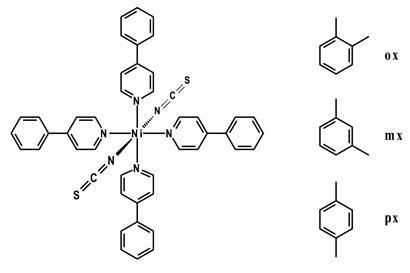Isomers of xylene simply separated in a process that could cut the energy costs of a wide range of chemical goods
An efficient new way to separate isomers of xylene, a chemical feedstock derived from crude oil, could slash the time and energy required to purify this key intermediate. Leonard Barbour and Matteo Lusi at the University of Stellenbosch, South Africa, have discovered a way to use host-guest chemistry to separate the isomers with remarkable selectivity. If the process proves to be scalable, products ranging from polymers and plastics to pigments and fungicides could benefit from the discovery.
Xylenes are benzene rings bearing two methyl side chains, in three possible configurations: ortho, meta and para. As xylene is produced from crude oil it is a mixture of all three isomers and most industrial processes demand a single isomer.

Unfortunately, xylene isomers have very similar physical properties, which makes separating the mixture no simple matter. For example, their boiling points differ by just a few degrees, ruling out distillation. Today’s industrial methods for separating xylene therefore involve slow, energy-intensive, multi-step processing.
Barbour and Lusi made their discovery while revisiting 50-year old research into the use of octahedral transition metal hosts able to complex xylene isomers. The original research involved co-crystallisation of host and guest from solution, a complex and costly process involving first dissolving the host in the liquid, then forming the crystals and finally separating these crystals and extracting the product. Barbour has now found a much simpler approach - exposing the solid complex to xylene vapour - which looks much more promising.
The team used a nickel-based metal complex, [Ni(NCS)2(para-phenylpyridine)4], as their host structure. When this polycrystalline material was exposed to a 1:1:1 vapour of xylene isomers, the orthoisomer was preferentially adsorbed with a selectivity of 95:4:1. When the remaining two isomers were then exposed to fresh nickel host, the meta isomer was preferentially taken up in the ratio 94:6. A single, solvent-free process involving industrial pressure-swing adsorption technology should therefore be able to separate and collect each isomer.
’It’s a significant breakthrough,’ says Colin Raston, who researches supramolecular and green chemistry at the University of Western Australia in Perth. ’These three isomers have been very energy-intensive to separate. With this process you simply absorb the isomers into a crystalline material and then desorb them. It really allows scaling up, and it would be a significant reduction in energy usage.’
The reason for the selectivity seems to come down to thermodynamics, Barbour concludes. ’We tried to come up with some sort of trend, based on the crystal structure of each host-guest complex, to explain the selectivity,’ he says. ’The only thing we could see was the energy of conformation of the complex itself - absorption of the ortho isomer from the vapour requires the least amount of distortion of the metal complex.’
The team now plans to test a series of nickel complex analogues to search for even higher selectivity. ’We’re now attuned to looking for this selectivity, and I think it’s very unlikely that we have stumbled upon the best complex for this process,’ Barbour says.
James Mitchell Crow
References
Matteo Lusi and Leonard J Barbour, Angew. Chem., Int. Ed. DOI: 10.1002/anie.201109084






No comments yet